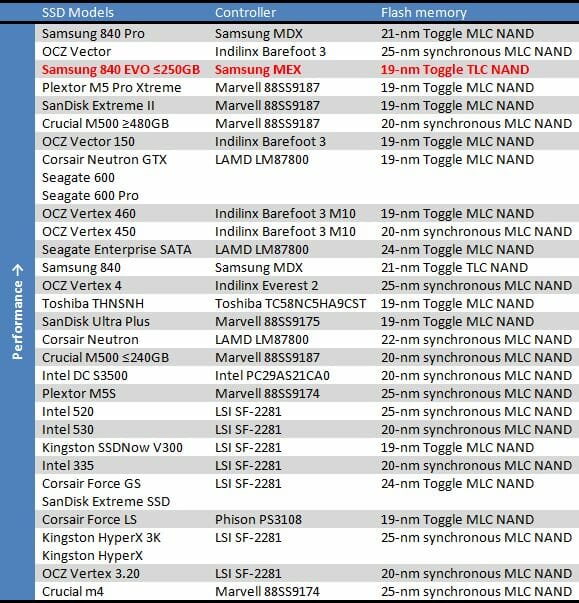Samsung 840 EVO Solid State Drive Review: Evolution by Samsung

Despite the current price war Samsung developers work on performance of their SSDs in addition to value. And Samsung 840 EVO is the result of such work. This SSD is one of the greatest technologically advanced drive for consumer market today.
We have to start all of our recent reviews of solid state drives with words about this market having lost its momentum and SSD makers having ceased to innovate. A number of small and dynamic firms have left after the semiconductor giants, being also the leading manufacturers of NAND flash memory, have taken up SSD business. And it is those small players that used to be the most instrumental in steadily pushing up the performance bar of consumer-class SSDs. Now that the market is dominated by Intel, Micron, Samsung and Toshiba with their huge shipment volumes, the speed race has transformed into a price war.
Of course, there’s nothing wrong about that from the end-user’s point of view. SSDs have really got cheaper lately. But enthusiasts who build top-performance computers don’t like this state of things. Fortunately, from among numerous SSDs with average performance specs we can still pick up a few products with unique properties. They are offered by Samsung which, besides optimizing the cost efficiency of its products, tries to make them superior in terms of pure speed.
Samsung seems to have plans on dominating the whole SSD market. The company took up this business later than its main competitors, so now it has to catch up through marketing and innovation. Samsung has been quite successful at that. Its SSDs are already among the most attractive products in terms of speed as well as price/performance ratio. There are two key factors to this success. First of all, Samsung has proprietary controllers which feature an ingenious architecture and high performance and keep on being perfected. And second, Samsung is a manufacturer of high-quality, cutting-edge and cost-efficient NAND flash memory.
We’re already familiar with Samsung’s 840 Pro and 840 SSDs which earned Samsung its good reputation among different categories of users. Based on a progressive 3-core MDX controller, the 840 Pro model delivered record-breaking performance whereas the 840 model with 3-bit TLC NAND flash memory is a not-very-fast but very cost-efficient SSD which is also highly reliable in terms of everyday use.
Samsung might have enjoyed high sales even with these models but the company decided to move on and combine the best properties of the two in a single product. To produce a fast and inexpensive SSD, Samsung took a revised version of the fast controller and 3-bit memory, adding a number of sophisticated technologies to mask the weak aspects of TLC NAND flash. The result is the Samsung 840 EVO drive which features most impressive specifications. In this review we will check out the 250GB version of the drive and see if Samsung has come up with a real bestseller. Interestingly, the first TLC-based drive, Samsung 840, enjoyed up to 20% of the retail SSD market at one moment. The new 840 EVO claims to be even better. So let’s see if it leaves any chance to its opponents.
Samsung 840 EVO: New Platform
Judging by its name, the new drive belongs to Samsung’s good old 840 series but the EVO suffix implies some improvements over the Samsung 840, the previous junior model. In this case, the marketing department has not given due credit to the developers, though. The Samsung 840 EVO is absolutely new. It has a new controller, new memory and new operating algorithms. In other words, we have a new generation of SSDs from Samsung hidden behind an old facade. Samsung doesn’t market the new SSD as an 850 series for some reason although it would be quite accurate given the internal design. Let’s take a closer look at it, by the way.
The Samsung 840 EVO is based on Samsung’s new MEX controller. The basic architecture of the chip has remained intact. Like the MDX controller in the earlier 840 series SSDs, it incorporates three ARM Cortex-R4 cores. The clock rate has grown by a third to 400 MHz, which improves the rate at which random-address operations are processed. The MEX controller supports SATA 3.1, so the Samsung 840 EVO can improve performance under heavy loads by queuing TRIM commands.
One more advantage of the new controller is its improved support for 256-bit AES encryption. Samsung SSDs could encrypt data earlier, but the 840 EVO introduces compatibility with the Trusted Computing Group Opal and Microsoft eDrive specifications. Thus, users of this drive can enjoy simple hardware encryption which can be managed from the OS, e.g. via the standard Windows tool BitLocker. Earlier, such encryption used to be enabled via an ATA password in the mainboard’s BIOS. That was not always possible or convenient.
The second fundamental innovation in the 840 EVO design is the new type of TLC flash memory. The drive’s predecessor Samsung 840 was the first SSD with TLC NAND flash that could store 3 bits of data in each memory cell. Samsung seems to have found this kind of memory appropriate for SSDs although some people argue that it’s not very reliable, being rated for only 1000 rewrite cycles. TLC flash memory did well in the Samsung 840 drive which proved to be quite reliable in practice. Many experiments conducted by enthusiasts have shown that you can write 250 (and even more) terabytes of data even with the 120GB version of the drive. It means that Samsung’s TLC-based SSDs are going to last for several years in an average desktop PC.
Interestingly, other manufacturers have not yet released any products with TLC NAND, so Samsung seems to have some proprietary technologies that help use 3-bit flash memory in the most efficient way. And now these technologies are improved further as the Samsung 840 EVO features a new type of TLC memory. As opposed to the 840 model’s 21nm flash memory, it features 19nm memory with Toggle Mode 2.0 DDR interface that has a peak bandwidth of 400 Mbps.
TLC NAND flash memory can store 50% more data than regular MLC NAND flash in a semiconductor device of the same complexity. Thus, it helps reduce the manufacturing cost of SSDs and lets the manufacturer sell them cheaper at the same profit. Having solved any reliability issues related to TLC NAND flash, Samsung can now keep on improving the manufacturing technology and make its SSDs even more profitable.
With the transition to the new manufacturing process Samsung has switched from 64- to 128-gigabit semiconductor dies. Micron’s MLC NAND flash with 128-gigabit dies was also employed in the recently tested Crucial M500. It helps increase the maximum capacity of SSDs to 1 terabyte, so the Samsung 840 EVO uses 128-gigabit dies for the same purpose. However, Samsung’s 19nm TLC flash differs from Micron’s MLC flash in being structured into 8KB rather than 16KB pages. Samsung’s flash memory is erased in 256-page blocks as is typical of 64-bit memory. All of this means that the transition to larger-capacity dies won’t increase write and erase latencies much. That’s good news since TLC NAND is overall slower than MLC NAND.
And now we should mention one more special feature of the Samsung 840 EVO which is meant to boost its performance. It is called TurboWrite. TLC memory is known to be slower than MLC. The “thinner” tech process lowers performance even more. As a result, the 19nm memory installed in the Samsung 840 EVO turned out to be too slow to make a fast SSD as Samsung wanted. The solution found by Samsung engineers is in using a cache which emulates SLC NAND flash memory. It stores 1 bit of data in each memory cell but works with extremely low latencies. The idea of such caching is quite obvious. Indeed, it has been long used in products from Toshiba and SanDisk. Samsung’s implementation differs in that the cache is only employed for writing. The high-speed SLC mode is limited to a part of TLC memory in the reserve pool inaccessible by the user. Even a small cache with SLC simulation turns out to be enough for a considerable boost in performance.
Depending on the drive’s capacity, the TurboWrite cache varies from 3 to 12 gigabytes.
When data is written to the drive, it is first written into the SLC cache and later, during an idle period, transferred into the TLC area. It means that the Samsung 840 EVO is going to deliver an extremely high writing performance at first but, if the amount of data exceeds the TurboWrite cache size, the speed goes down since the drive has to save data into slow TLC instead of fast SLC memory. Writing large amounts of data continuously isn’t a typical load for everyday applications, though. That’s why we can expect the TurboWrite technology to be most beneficial in practice.
The TurboWrite cache makes up for the reduced reserve pool of memory cells. The caching of write operations allows to consolidate them and reduce the write amplification level. So, even though the reserve pool is only 5.6% of its total storage capacity, the Samsung 840 EVO should be as reliable as other consumer-class SSDs.
Summing up our overview of the new SSD platform implemented in the Samsung 840 EVO, let’s take a look at the specified speed compared to Samsung’s previous products.
As you can see, the new SSD is very close to the Samsung 840 Pro in its specs. Its good write speed is ensured by the TurboWrite technology whereas its good read speed relies on the new Samsung MEX controller. Well, it wouldn’t be exactly correct to view the Samsung 840 EVO as the 840 Pro model selling at the price of the Samsung 840. There are a lot of nuances the manufacturer doesn’t talk much about. It is to reveal them that we are going to test a 250GB version of the Samsung 840 EVO drive. Let’s have a look at its design first.
A Closer Look at Samsung 840 EVO 250GB
Samsung’s solid-state drives may come in different versions as desktop or mobile upgrade kits but ours is an OEM version. Even in this case the Samsung 840 EVO is packed into a neat small box. Besides the SSD, the box contains some papers and a CD with software and electronic user manual.
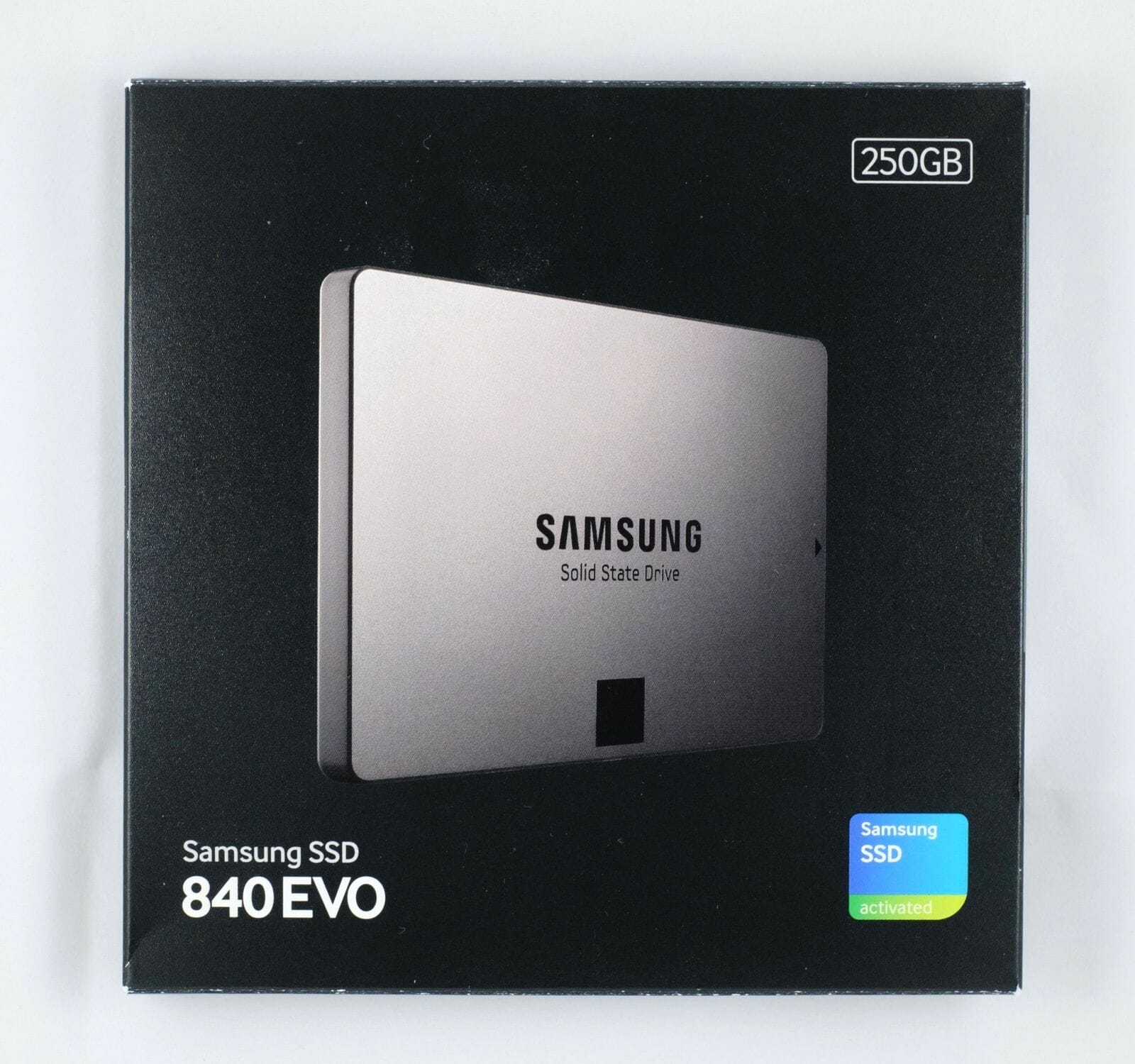
The restrained design of the packaging is Samsung’s typical. The box is made of black cardboard, showing a picture of the SSD on its front. The contents of the box are listed on its back with a few marketing slogans.
The exterior design of the SSD has somewhat changed since Samsung’s earlier products. The shape and materials of the case are the same but the 2.5-inch metallic brick is painted differently. Instead of lusterless powder paint, we have a “wet-asphalt” coating. The manufacturer’s logo on the top of the drive is now black.
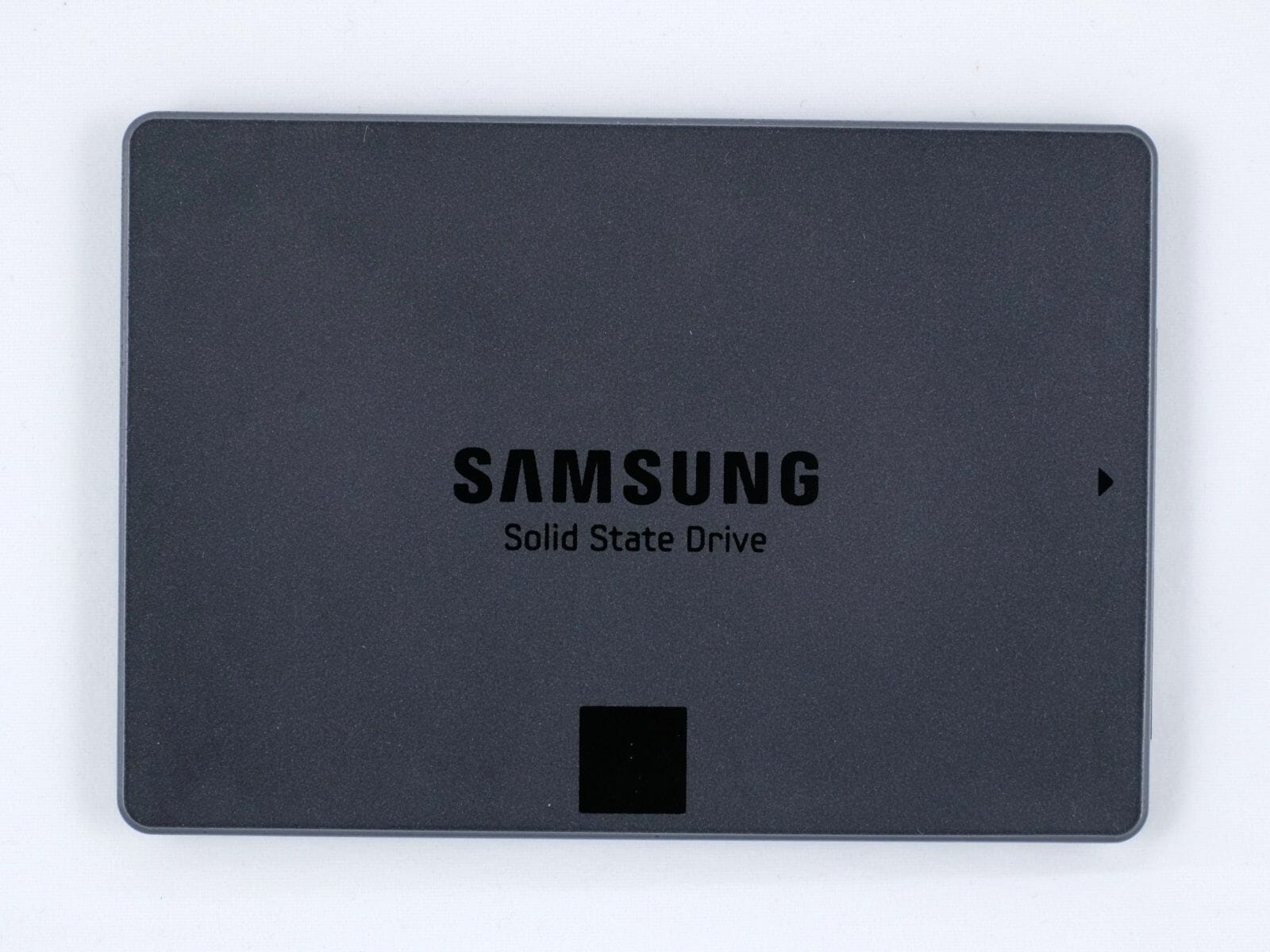
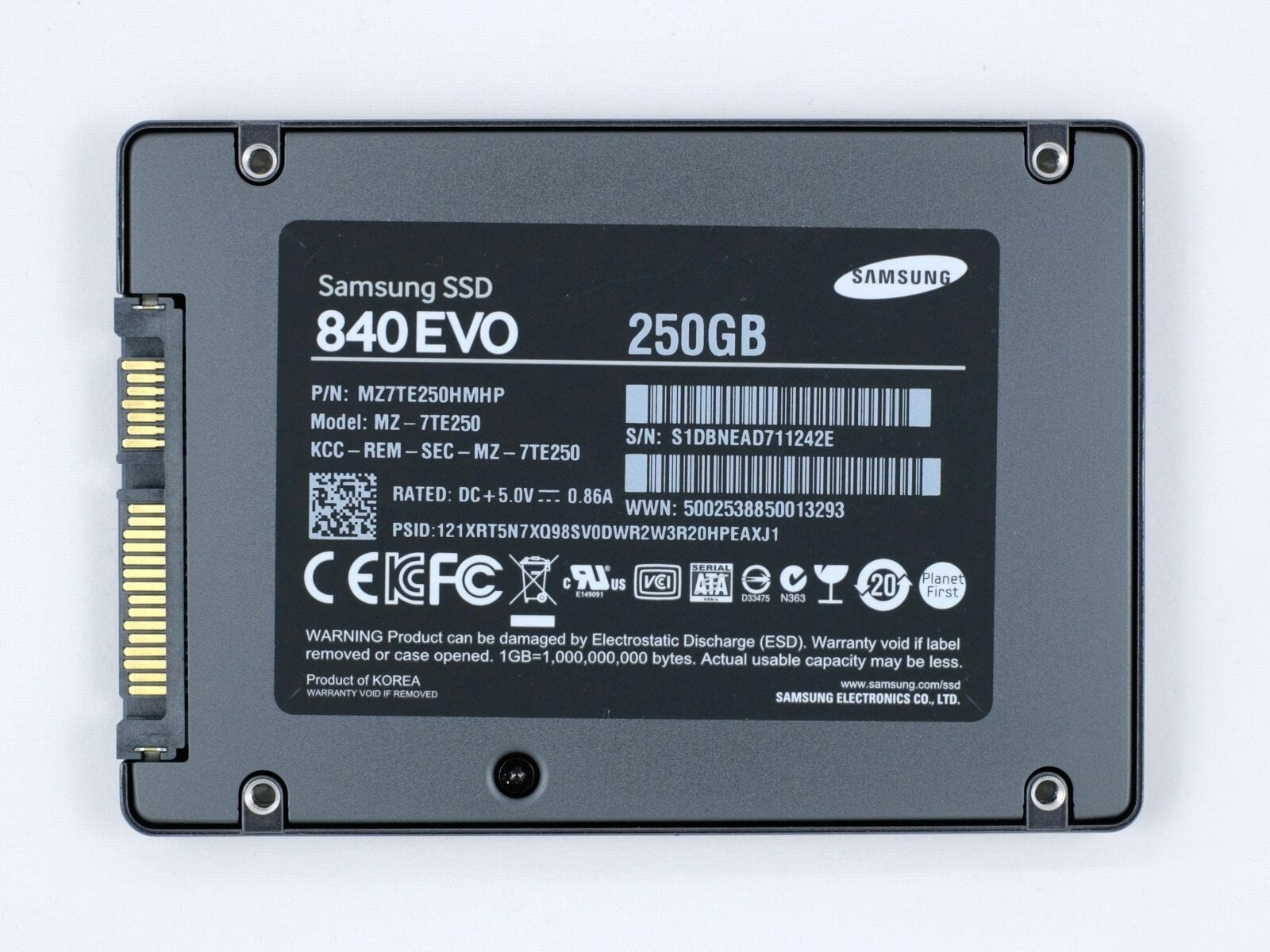
The SSD is 7 mm in height, so it can be easily installed into ultra-slim notebooks. The Samsung 840 EVO is also very light at just 43 grams.
There’s a sticker on the bottom of the SSD with its name, serial and part numbers, and other information which is hardly important for end-users. What is important, you can see a PSID, which may be required to reset the encryption password (losing all data at that).
The humble-looking case contains most extraordinary internals. The PCB installed inside the Samsung 840 EVO is amazingly small. We’ve never seen such tiny PCBs inside 2.5-inch SSDs before.
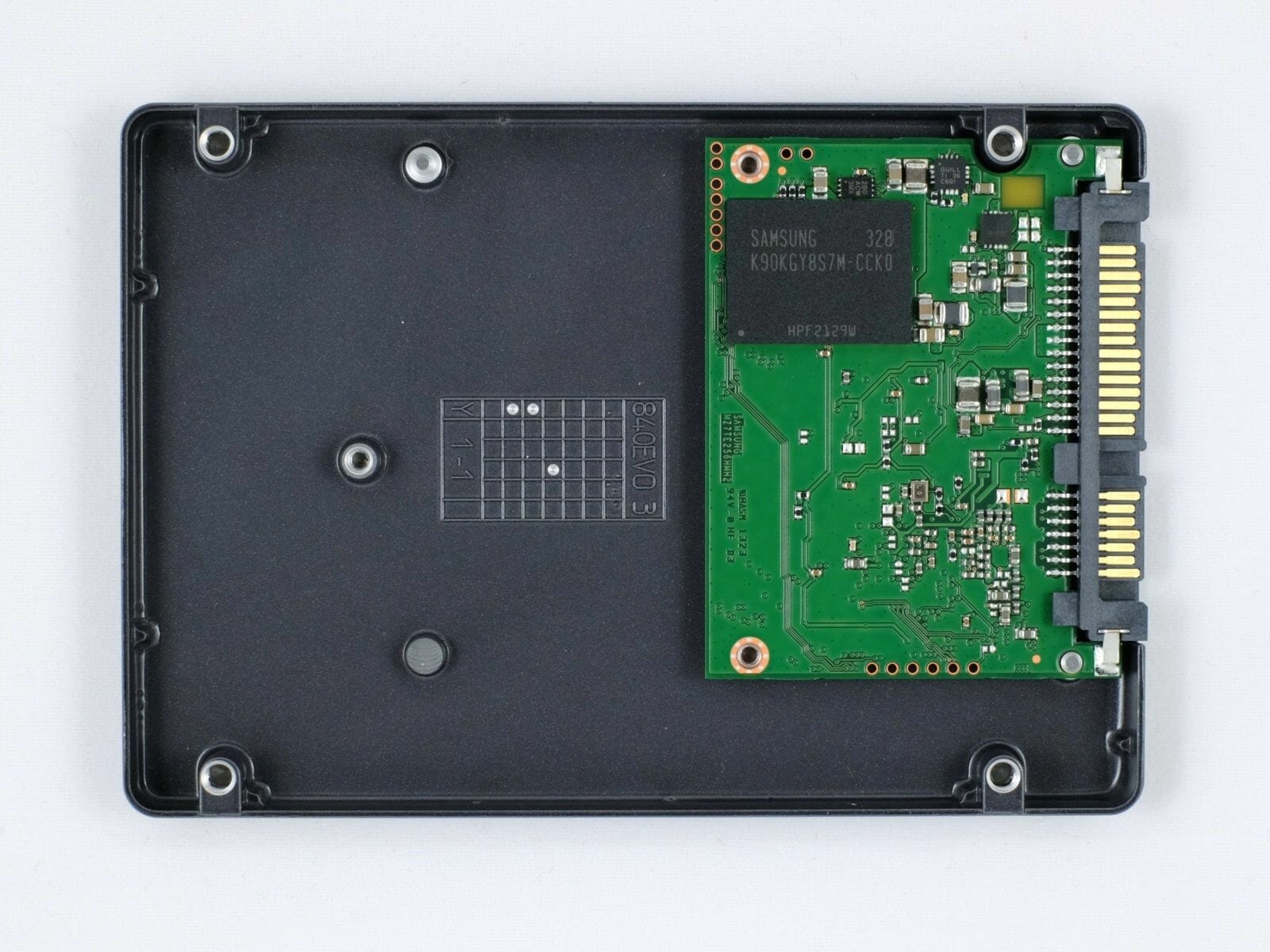
Even more amazingly, there are only four chips on the PCB. The most important of them is the S4LN045X01-B030 controller. The Samsung 840 EVO employs LPDDR2-1066 SDRAM for storing firmware and address translation table. It is represented by a single 256MB chip. The other SSDs in this series have different amounts of SDRAM: 1 MB of cache per 1 GB of storage capacity.
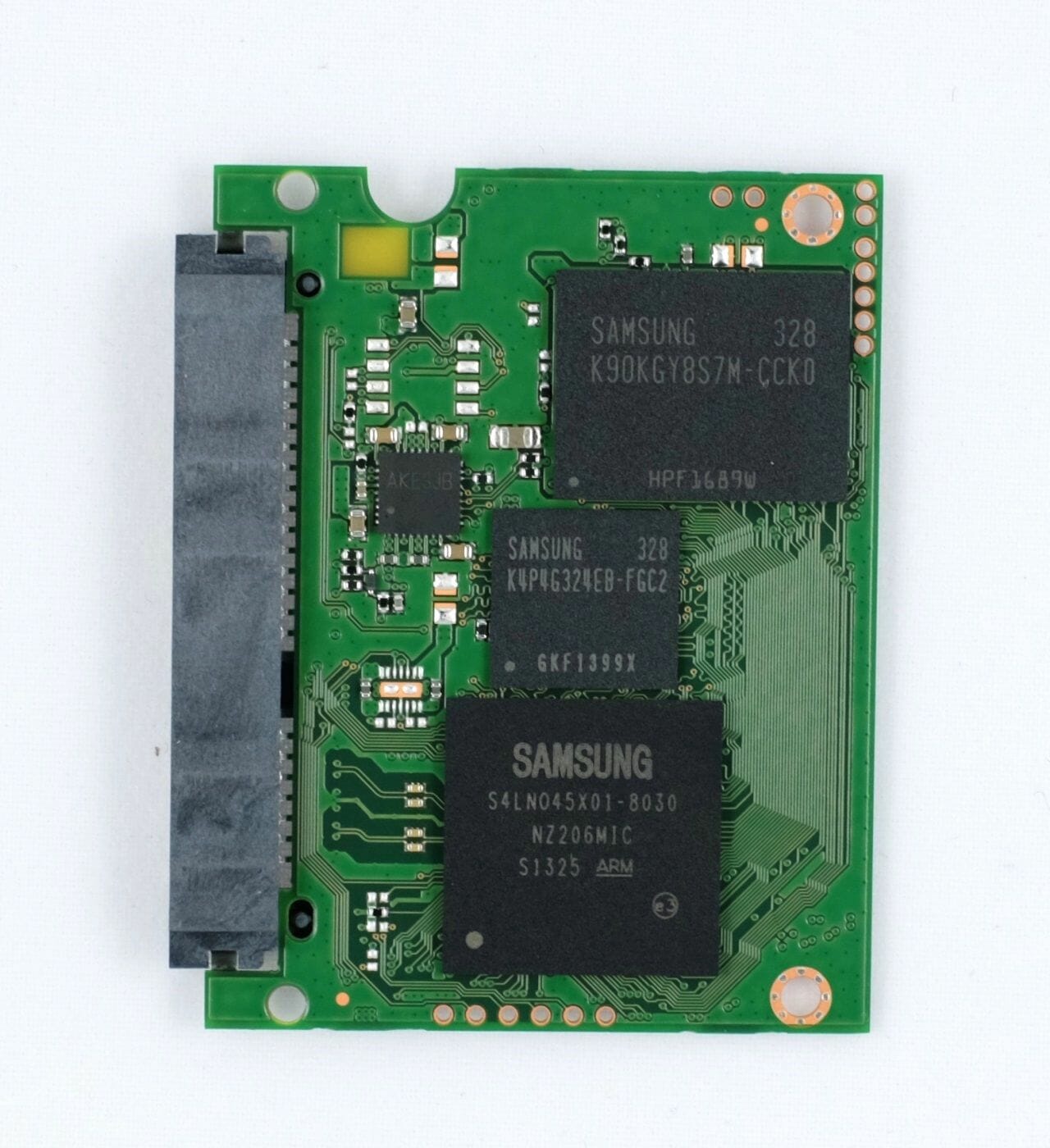
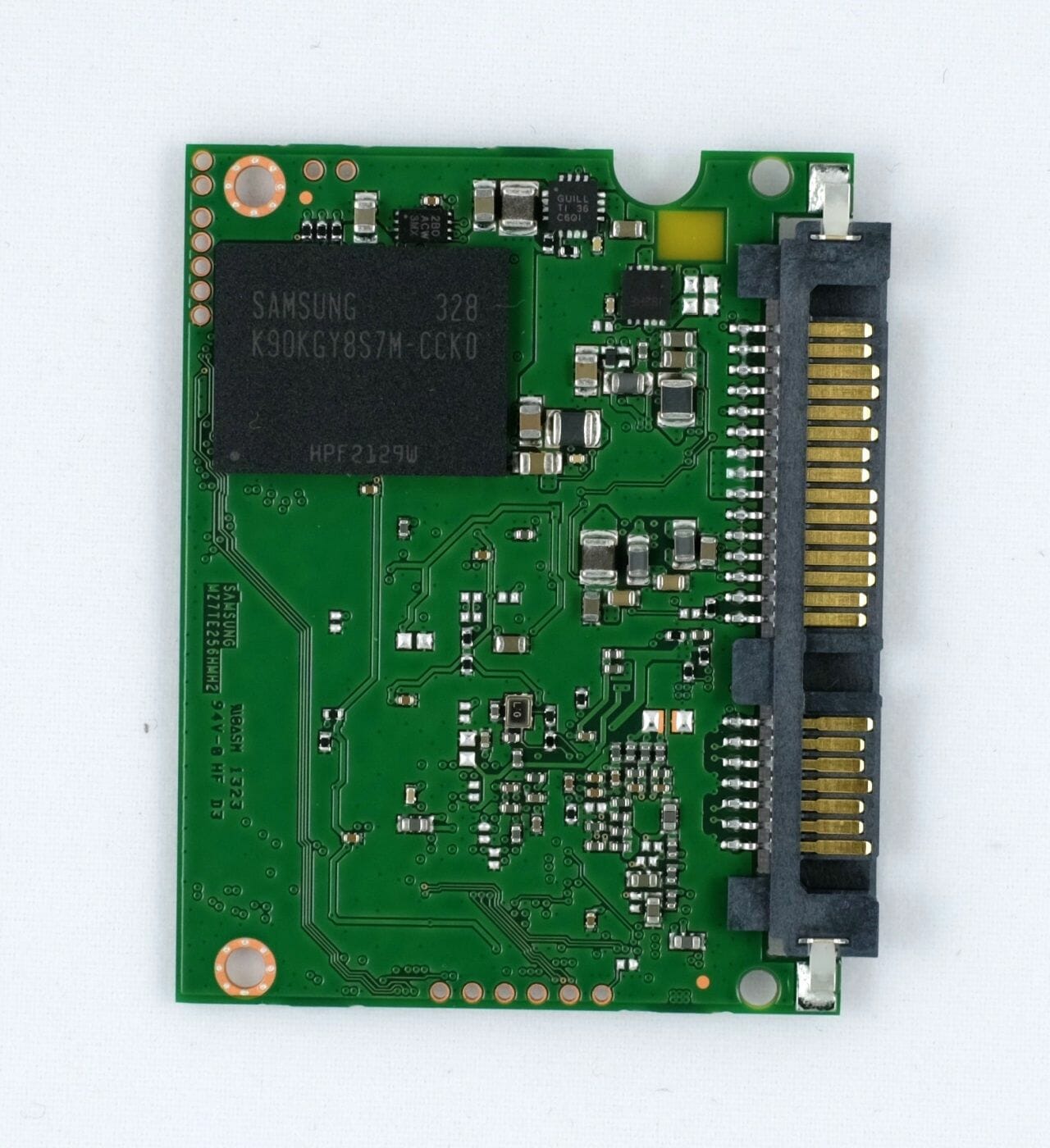
Now, the most interesting thing is how 256 gigabytes of TLC flash memory can fit into just a couple of chips. It turns out that each chip is 128 gigabytes in capacity, consisting of eight 128-gigabit TLC NAND flash memory dies. Samsung has achieved an unprecedented level of component density with the transition to 19nm technology as earlier we only had chips with up to four dies inside.
The 8-channel Samsung MEX controller only uses 2-way interleaving on each channel in this SSD. That’s not the fastest option possible because 4-way interleaving ensures higher speed. That’s the downside of Samsung’s transition to 128-gigabit NAND devices. As with the Crucial M500 series, the Samsung 840 EVO will deliver maximum performance in its 500GB and larger-capacity versions. The two junior versions, including the 250GB one we’ve got for our tests, are somewhat slower.
Interestingly, the new SSD from Samsung lacks any thermal interfaces. None of the chips has contact with the case but that’s not really necessary. They do not get very hot at work. Samsung also says that the SSD features overheat protection which is triggered when the controller gets hotter than 70°C.
The specifications of the Samsung 840 EVO 250GB are listed below:
- Controller: Samsung MEX
- Interface: SATA 3.1 (6 Gbit/s)
- Flash memory: synchronous 19nm Toggle Mode 2.0 TLC NAND
- Storage capacity: 250 GB (233 gibibytes)
- Cache memory: 256 MB LPDDR2-1066 SDRAM
- Sequential read speed: 540 MB/s
- Sequential write speed: 520 MB/s
- Random read speed (in 4KB data blocks): 97,000 IOPS
- Random write speed (in 4 KB data blocks): 66,000 IOPS
As expected, the Samsung 840 EVO 250GB is somewhat slower than the senior modifications, mostly in terms of random writing. The TurboWrite cache is capable of making up for that, so the performance difference will only be noticeable in applications that write a lot of data continuously.
Testbed and Methods
We test SSDs on a special testbed based on a mainboard with Intel H77 chipset. The latter has two SATA 6 Gbit/s ports and we connect the tested drives to one of these ports.
Since this review covers an SSD which claims to deliver high performance at an affordable price, we want to pit it against a number of popular SSDs of different classes. Of course, we will also compare the Samsung 840 EVO with its predecessors Samsung 840 Pro and Samsung 840 which are based on the previous-generation Samsung MDX controller and use Samsung’s own 21nm MLC and TLC flash memory.
Besides the three SSDs from Samsung, we will have a Seagate 600 (with LAMD LM87800 controller), Plextor M5 Pro Xtreme, Crucial M500 and SanDisk Extreme II (with Marvell’s flagship 88SS9187 controller), Plextor M5S (with Marvell 88SS9174 controller), Intel 530 (with the good old SandForce SF-2281 controller), and OCZ Vector 150 (representing the proprietary Indilinx Barefoot 3 platform). The Plextor M5 Pro Xtreme, SanDisk Extreme II, OCZ Vector 150 and Seagate 600 are equipped with 19nm MLC NAND from Toshiba/SanDisk. The Plextor M5S uses 25nm flash memory from Micron, the Samsung 840 Pro is based on Samsung’s own 21nm MLC flash, and the Intel 530 features Intel’s 20nm MLC NAND flash. The Crucial M500 is equipped with Micron’s new 20nm flash with 128-gigabit cores and 16KB memory pages.
The tested SSDs have similar storage capacities (240/250/256 GB).
Here is a list of all hardware components we will use in this test session:
- CPU: Intel Core i5-3470S (Ivy Bridge, 4 cores, 2.9 GHz, EIST and Turbo Boost disabled)
- Mainboard: Intel DH77DF (BIOS 0108)
- System memory: 2x2GB DDR3-1333 SDRAM (9-9-9-24-1T)
- System disk: Crucial m4 256GB (CT256M4SSD2)
- Tested SSDs:
- Crucial M500 240GB (CT240M500SSD1, firmware MU03)
- Intel SSD 530 240GB (SSDSC2BW240A4, firmware DC32)
- OCZ Vector 150 240GB (VTR150-25SAT3-240G, firmware 1.2)
- Plextor M5 Pro Xtreme 256GB (PX-256M5P, firmware 1.06)
- Plextor M5S 256GB (PX-256M5S, firmware 1.05)
- Samsung 840 Pro 256GB (MZ-7PD256, firmware DXM05B0Q)
- Samsung 840 EVO 250GB (MZ-7TE250, firmware EXT0BB6Q)
- Samsung 840 250GB (MZ-7TD250, firmware DXT08B0Q)
- SanDisk Extreme II 240GB (SDSSDXP-240G, firmware R1311)
- Seagate 600 240GB (ST240HM000, firmware C675)
- Operating system: Microsoft Windows 7 Ultimate (SP1, 64-bit)
Drivers:
- Intel Chipset Driver 9.4.0.1027
- Intel HD Graphics Driver 10.18.10.3345
- Intel Management Engine Driver 9.5.0.1367
- Intel Rapid Storage Technology 12.9.0.1001
Performance
Sequential/Random Read and Write
We use Anvil’s Storage Utilities 1.0.51 to measure random and sequential read and write speeds of our SSDs. The synthetic benchmark integrated into this software suite provides a great overview of the tested products by checking out their key speed characteristics. The results you will see here refer to the FOB performance (fresh out-of-box, i.e. non-degraded) of the SSDs. It must also be noted that we use incompressible data for this test.
The first results of the synthetic benchmark suggest that the Samsung 840 EVO is an excellent drive indeed. It is fast because it is superior to all the opponents at random-address reading with a short request queue, which is the most important parameter for consumer-class SSDs. As for other usage scenarios, the 840 EVO is only relatively weak at random-address operations with a long request queue. That’s not a typical load for the disk subsystem of a regular desktop computer, though.
So Samsung seems to have successfully reached the initial goal. The new SSD with TLC NAND flash memory is indeed comparable to flagship products from other brands in terms of performance. There is only one thing we should be aware of. The high writing performance of the Samsung 840 EVO is ensured by the TurboWrite technology, which is only efficient when rather small chunks of data are being written continuously. To illustrate this fact, we can show you how the linear write speed of the 840 EVO changes as the drive is being filled with data.
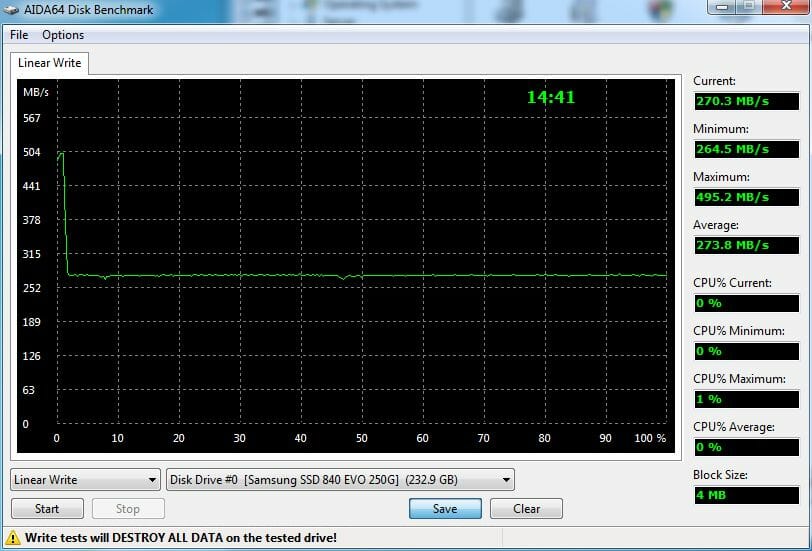
First, the Samsung 840 EVO really delivers an outstanding linear write speed, which is limited by the SATA 6 Gbit/s bandwidth. It cannot maintain that speed for long, though. The 250GB model we are testing today has a TurboWrite cache which is only 3 GB large. So after writing 3 gigabytes, the drive’s speed sags to the bandwidth of 8-channel TLC NAND flash with 2-way interleaving on each channel. To be precise, the initial write speed is up to 495.2 MB/s but then it goes down to about 280 MB/s.
Hence yet another fact: synthetic benchmarks may disagree in their estimate of the Samsung 840 EVO’s write speed depending on what amount of data they use for testing. For example, we use 8GB arrays of data, so the results are far from the possible maximum. To check this out, we additionally measured how the write speed changed depending on the amount of data.
It is the speed of sequential and random-address writing with a long request queue that depends the most on the amount of data. These parameters are limited by the flash memory bandwidth, so the TurboWrite technology is the most beneficial for them. When the request queue is short, the speed of random-address writing depends on the controller’s performance rather than on flash memory, so it doesn’t change much as the amount of written data increases.Performance Degradation, Garbage Collection and TRIM.
Unfortunately, SSDs are not always as fast as in their fresh out-of-box state. In many situations their real-life performance goes down far below the numbers you have seen in the previous section of this review. The reason is that, having run out of free pages in flash memory, the SSD controller has to erase memory pages before writing to them, which involves certain latencies. Modern SSD controllers can alleviate the performance hit by erasing unused flash memory pages beforehand when the SSD is idle, which is the key idea of the Idle-Time Garbage Collection algorithm whose implementation has a strong effect on the real-life performance of any SSD.
An SSD controller doesn’t know which memory pages contain user data and which are considered empty by the OS. It’s because removing a file doesn’t involve its actual physical removal. Instead, the corresponding memory is marked in the file system as available for writing into. So, an SSD controller can only pre-erase pages in the reserve pool (if it exists) which is not accessible by the OS. For a better solution of this problem, modern OSes have the TRIM command which improves garbage collection efficiency. TRIM enables the SSD controller to physically remove unneeded data so that the user didn’t feel a performance hit during subsequent write requests.
This is how it should be theoretically. In practice, however, SSDs differ in their garbage collection and TRIM support. That’s why we check out the performance hit an SSD suffers when transitioning from its out-of-box (the flash memory is clean) to used state. This test follows the SNIA SSSI TWG PTS guidelines, which means that we measure the speed of writing in four cases one by one: 1) when the SSD is in its out-of-box state, 2) after the SSD has been twice filled full with data, 3) after a 30-minute pause that allows the SSD controller to restore performance by means of data reorganization and garbage collection, and 4) after the SSD is cleaned logically by the TRIM-supporting OS.
So we use IOMeter 1.1.0 RC1 to measure the speed of writing random-address 4KB data blocks aligned to flash memory pages at a request queue depth of 32. The test data are pseudo-random. The changes in speed are shown in the next diagram where 100% is the SSD’s out-of-box performance.
The Samsung 840 EVO features a perfect TRIM implementation, which lets the drive keep its original performance over time. Well, Samsung drives have never had any problems with TRIM, actually.
As for background garbage collection (without TRIM), the diagram shows that it is present, too. The Samsung 840 EVO gets faster after being idle for a while whereas earlier SSDs from Samsung couldn’t do that. Well, it is also possible that this performance improvement is due to clearing the TurboWrite cache rather than to background garbage collection. Anyway, the 840 EVO always works faster after a brief idle period both in TRIM-supporting and in non-TRIM environments.
Futuremark PCMark 8
Futuremark PCMark 8 contains a special disk subsystem benchmark. It is not a synthetic test but is based on real-life applications. This benchmark reproduces typical disk usage scenarios and measures how fast they are performed. Compared to PCMark 7, it features more scenarios based on Adobe and Microsoft applications as well as games. The result is calculated as the average speed across all of the subtests.
We run PCMark 8 on steady-state SSDs, just as they are going to be used in actual computers. Their performance in this case is affected not only by their controller or flash memory speed but also by the efficiency of their internal algorithms that fight performance degradation.
As opposed to synthetic benchmarks, PCMark 8 emulates real-life disk usage scenarios by running pre-recorded disk activity traces. PCMark 8 is thus indicative of what performance we can expect from SSDs in practice. Here, we can see that Samsung’s drive with inexpensive TLC NAND flash memory is indeed capable of delivering top-class speed. The Samsung 840 EVO is only inferior to the Samsung 840 Pro but outperforms a lot of popular products such as the Plextor M5 Pro, SanDisk Extreme II and OCZ Vector 150. The Samsung 840 EVO benefits from its high random read speed and TurboWrite technology which can mask the drive’s low write speed.
The overall PCMark 8 results are the average of the individual subtests, so let’s check the latter out, too.
The Samsung 840 EVO is only relatively weak in the few applications that call for writing a lot of data, e.g. Adobe After Effects. In the majority of other cases, the Samsung 840 EVO is just a little slower than the leading Samsung 840 Pro.
Intel NAS Performance Toolkit
Intel NASPT is another disk sub-system test that employs real-life usage scenarios. Like PCMark 8, Intel NASPT reproduces predefined disk activity traces and measures how fast they are executed. However, the default traces are designed for network attached storage devices rather than for SSDs. Therefore during our test session we replace them with the specially developed SSD Benchmarking Suite which offers more relevant usage scenarios such as compressing and decompressing files, compiling large projects, copying files and folders, loading 3D game levels, installing software, batch-processing photos, searching a digital library for data, mass-launching applications, and transcoding video.
Like PCMark 8, this benchmark gives us a true-to-life illustration of disk subsystem performance. Here the SSDs are again tested in their “steady” state.
The leader Samsung 840 Pro is followed by the Samsung 840 EVO in this benchmark, too. Interestingly, by combining technologies from the 840 Pro and the 840 models, Samsung has created an SSD that is in between them in performance. That’s quite enough for the new drive to beat most of the flagship products from other brands.
Besides the average benchmark score, we would also like to offer you the results of individual usage scenarios, which explain the overall results of the Samsung 840 EVO. Take note that the data-transfer rate is higher than the SATA interface bandwidth in some subtests. That’s because INASPT is a high-level benchmark that uses standard Windows functions to access the disk subsystem. The OS’s caching mechanisms come into play then.
It is easy to explain the numbers we see in these charts. The Samsung 840 EVO falls behind its opponents whenever it is required to write a lot of data continuously like in the file copy and software installation scenarios. Otherwise, the 840 EVO is confidently in the top part of each diagram. It is even occasionally ahead of the flagship Samsung 840 Pro model thanks to the MEX controller’s higher speed of random-address reading.
File Copy Speed
We use AS SSD version 1.7.4739.38088 to benchmark the speed of copying different types of files within a single partition the size of the whole SSD. The SSDs are tested in their steady state again.
Copying files within the same SSD is a specific load which requires high speed of processing both read and write requests simultaneously. The Samsung 840 EVO doesn’t perform consistently here. Its speed depends on the type of data and, obviously, on whether the copied files can fit into the TurboWrite cache.
RAPID Software Cache
In our tests of the Samsung 840 Pro and Samsung 840 we noted that they came with Samsung Magician, one of the best SSD management utilities available. It has a user-friendly interface and a lot of features from viewing SMART information and updating firmware to Secure Erase, an in-built performance benchmark and an OS optimizer. The utility has been updated for the Samsung 840 EVO and now supports the exclusive RAPID technology.
RAPID (Real-time Accelerated Processing of IO-Data) implements an additional level of caching in the OS. With RAPID enabled, the Magician tool creates a cache buffer in system memory to accelerate read and write operations. This functionality is based on solutions from NVELO, which has recently been bought by Samsung. NVELO is known among enthusiasts for its optimizations of hybrid disk subsystems consisting of an SSD and an HDD. Now this technology has been adapted for using with an SSD and system memory.
Currently RAPID is supported by Samsung’s 840 EVO and 840 Pro drives. Although it is a software technology, it cannot be enabled for other SSDs. RAPID requires at least 2 gigabytes of system memory and Windows 7 or 8. You enable it by simply clicking a button in the Magician interface.
After rebooting, a 1GB cache is created in system memory to store low-level read/write disk requests to the Samsung drive, improving the latter’s performance. According to the synthetic benchmark CrystalDiskMark, the Samsung 840 EVO gets as fast as PCIe drives when you enable RAPID.
It must be noted that RAPID can only accelerate reading when the same data is accessed repeatedly, so it can be taken from the cache. That’s why real-life applications may not show such a high performance boost. The performance benefits we’ve got with our configuration in PCMark 8 after enabling RAPID are illustrated by the following table.
As you can see, the RAPID effect varies greatly between applications. It is low in games but huge in Photoshop. The average performance growth is an impressive 55%.
Despite the substantial performance benefits from RAPID, many users don’t like such software technologies since they lower the robustness of the file system. If the computer fails while the RAM cache contains data which is not yet written to the SSD, the data may get lost and the entire file system may get damaged.
Samsung says that such problems are very unlikely as the RAPID technology tries to keep data in the RAM cache for as little time as possible. Instead of quickly processing write requests by placing them in the cache, the point is in combining random-address requests with a short request queue into long-queue requests.
RAPID takes a rational approach to system resources. The system memory employed for disk requests is freed up when requested by other OS processes. The technology itself may temporarily switch off when the CPU load is high.
Conclusion
Judging by its design features, the Samsung 840 EVO is something in between Samsung’s 840 Pro and 840 models – a top-performance SSD with inexpensive TLC NAND flash memory. This description is rather superficial, though. Samsung has put much effort into improving the SSD architecture and endowed the 840 EVO with innovative technologies. The resulting product is quite outstanding. A revised controller with increased clock rate, 19nm flash memory with 128-gigabit cores and TurboWrite technology make the Samsung 840 EVO a high-performance solution which is also available in different capacities, up to 1 terabyte. Even though we tested a 250GB version of the drive, which is not the fastest version available, it outperformed most of the flagship SSDs from other brands. So, rather surprisingly, the Samsung 840 EVO turns out to be second only to the Samsung 840 Pro in terms of speed.
Talking about its downsides, we should realize that the 840 Pro is a consumer-class product. It is not designed for high loads, being based on 3-bit TLC NAND flash with a rather limited service life. Even though Samsung’s TLC NAND flash is quite reliable, making the 840 EVO suitable for desktop computers, an SSD with MLC NAND flash would last longer under the same conditions. That’s why the Samsung 840 EVO comes with a 3-year warranty despite delivering top performance.
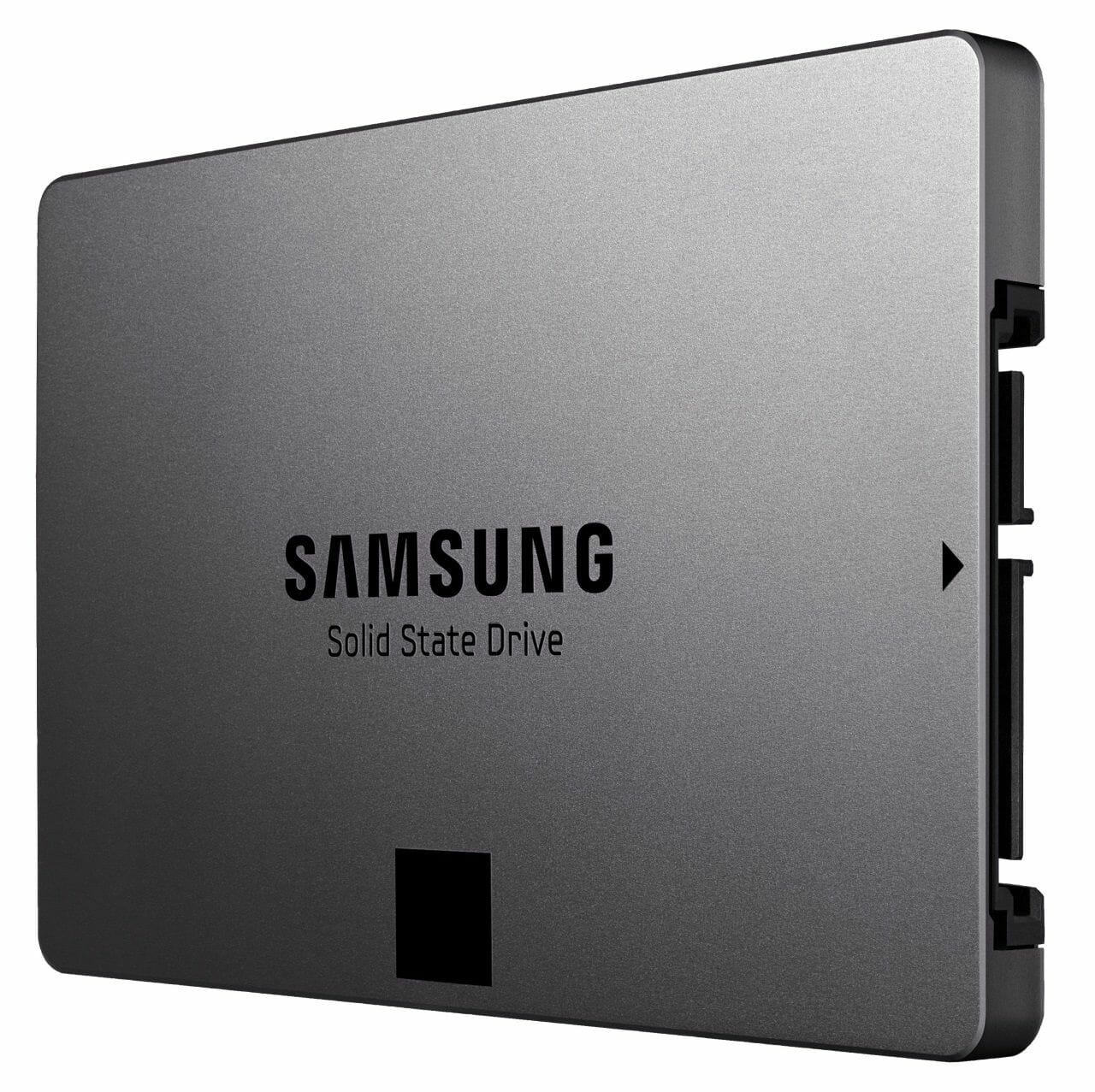
We are also disappointed with Samsung’s pricing policy. The 840 EVO is based on inexpensive TLC memory, so it might come at a rather low price. However, this SSD currently costs more than inexpensive products with MLC NAND flash, e.g. Crucial’s M500. So, even though the Samsung 840 EVO is an excellent SSD, you may want to check out other products if you’re looking for the best price/performance ratio.
To help you with your choice, we offer the following summary table with test results of various SSDs. It contains basic hardware information about SSDs we’ve tested so far and allows to quickly determine the general position of a particular model among its competitors in terms of relative performance.
